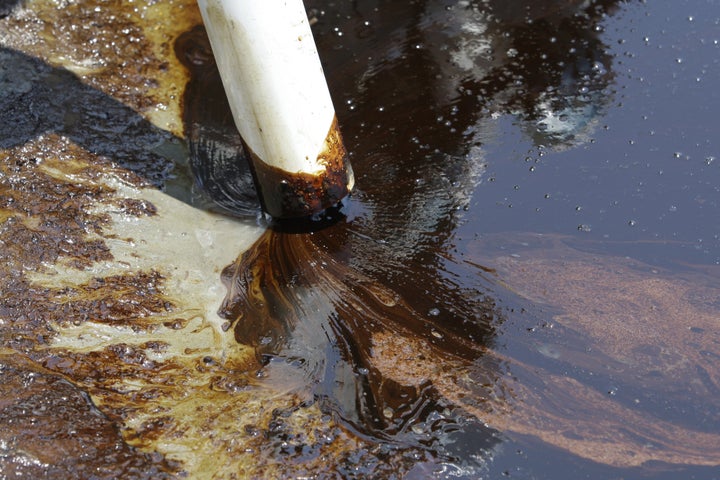
In the more than seven weeks since its deep-sea well exploded and began belching oil and gas into the Gulf of Mexico, all BP has done is make the leak worse.
The "top kill" attempt that shot tons of mud down the well pipe in an attempt to plug it didn't work -- and may instead have scoured the pipe clean of blockage that was keeping some of the oil down. It could also have set the stage for a catastrophic structural failure.
Cutting off the snarled riser pipe in order to install a containment cap significantly increased the flow of oil and gas -- possibly by more barrels per day than the cap is actually capturing.
And the more than 1.1 million gallons of dispersant that BP has applied to the leaking oil has simply spread it around, making it harder to see and collect (and assess damages for) -- but has not made it any less harmful to the environment. Indeed, the dispersant itself is toxic and is likely killing essential oil-eating bacteria.
When it comes to BP's efforts to protect and clean the shorelines, countless miles of containment booms have been deployed in ways that don't do any good at all, while BP isn't providing workers on land or sea with the appropriate protection against harmful chemicals.
Meanwhile, throughout the last 53 days, the company has been consistently secretive and/or misleading about essential information, including such basic things as the amount of oil and gas being released into the water and the precise steps being taken to try to fix it.
All of which tends to reduce confidence when BP says it can do something going forward, whether it's put a tight cap over the leak in the near term, as the Coast Guard has ordered the company to do, or even plug it from below by digging relief wells sometime in the next few months, which the company has repeatedly stated it can accomplish.
Some scientists who have been following developments particularly closely are starting to worry that given BP's track record thus far, even greater catastrophe lies ahead.
"It is quite feasible that whatever the oil is doing now, which we think is really bad, could be the good time," said Ira Leifer, a researcher at the Marine Science Institute of the University of California, Santa Barbara, who is also a member of the federal study group trying to determine the daily flow from the leak.
Leifer's overriding concern is that the lack of accurate measurements of flow and pressure is leading to bad choices by those trying to plug the leak. "It's being done without any numbers," he told the Huffington Post. "That's not how you do science. The problem here is a rush to solve the problems without getting some numbers so it can be done safely, and as a result, making it worse."
The latest series of estimates from the various teams of scientists trying to determine the flow rate, while higher than they had been previously, are also conflicting, range widely, and may still be too low. The government is now estimating that the flow -- before the riser was cut June 3 -- was somewhere between 20,000 and 40,000 barrels a day.
And yet, even with about 15,000 barrels of oil a day are being captured by the new cap, the roiling cloud of filth captured on live video appears undiminished.
Leifer said that if engineers had known just how forcefully the oil was shooting out of the reservoir, they would not have attempted the "top kill," because they would have known it wouldn't work. Instead, the procedure effectively "sandblasted the inside of the pipe," he said. "If they'd left it clogged and messy and then cut it, then less would have come out of it."
Cutting the kinked riser pipe also undoubtedly increased the flow of oil, though by how much is another mystery.
And drilling the relief wells is anything but a surefire solution, Leifer said. Even if a relief well bore is able to connect up with the original, that could backfire -- either literally, by causing another explosion (as recently happened with a relief well in Australia), or figuratively, if the structural integrity of the rock above the reservoir has been undermined.
Leifer's worst-case scenario is that something BP does (or has already done) will destroy the well's structural integrity in a way that the oil and gas from the reservoir deep below starts to break out either in a massive rupture that spews out "a billion gallons in a month" -- or through widespread fractures in the seabed. "That could go on for year and years," Leifer said.
"At some point," he said. "it's at the point where everything's dead."
"It's been failure after failure after failure, so far," said Rick Steiner, a marine scientist consulting with Greenpeace.
Steiner has recently been witnessing the work BP has done deploying booms along the coastline. "They are just now starting to correctly boom some of the seabird nesting islands, but that took a while," he said. "Initially, they were putting a lot of boom out and not tending it at all, just going home." As a result, "it was breaking its anchors, and drifting up on beaches, and doing absolutely nothing."
BP -- and the government -- have lost so much credibility over the last eight weeks, and have established so many filters between the decisionmakers and the public, that Steiner said the only solution is to give independent observers full access to the operations going forward.
"What's most important is to have the accurate information about whatever they are trying and every problem they are encountering," Steiner said.
Steiner is hopeful that the relief well will end the leak. Once the two well bores meet, BP engineers will pump mud and then concrete down the relief well. The mud and concrete should then go up the blown-out well and, hopefully, plug it.
It's not so much that Steiner has great confidence in BP -- or in any technological solution that far beneath the sea. It's just that the alternative is too hard to contemplate.
"If that doesn't work, we're kind of SOL," he said. "If the relief wells don't work, boy we're in really deep trouble."
*************************
Dan Froomkin is senior Washington correspondent for the Huffington Post. You can send him an e-mail, bookmark his page; subscribe to RSS feed, follow him on Twitter, friend him on Facebook, and/or become a fan and get e-mail alerts when he writes.
